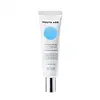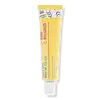What's inside
What's inside
 Key Ingredients
Key Ingredients

 Benefits
Benefits

 Concerns
Concerns

No concerns
 Ingredients Side-by-side
Ingredients Side-by-side

Water
Skin ConditioningGlycerin
HumectantCetearyl Alcohol
EmollientDipropylene Glycol
HumectantDicaprylyl Carbonate
EmollientHydrogenated Polydecene
Emollient1,2-Hexanediol
Skin ConditioningVinyldimethicone
Cyclohexasiloxane
EmollientButylene Glycol
HumectantHydrogenated Coconut Oil
EmollientPropanediol
SolventCetearyl Olivate
Sorbitan Olivate
EmulsifyingCetearyl Glucoside
EmulsifyingCarbomer
Emulsion StabilisingTromethamine
BufferingDimethicone/Vinyl Dimethicone Crosspolymer
Skin ConditioningSodium Polyacryloyldimethyl Taurate
Emulsion StabilisingParfum
MaskingEthylhexylglycerin
Skin ConditioningAdenosine
Skin ConditioningDisodium EDTA
Trideceth-10
CleansingSodium Hyaluronate
HumectantHydrolyzed Hyaluronic Acid
HumectantHyaluronic Acid
HumectantRaphanus Sativus Seed Extract
Skin ConditioningRoyal Jelly Extract
Skin ConditioningPanthenol
Skin ConditioningGlucose
HumectantCaprylic/Capric Triglyceride
MaskingHydrolyzed Keratin
HumectantHydrogenated Lecithin
EmulsifyingButyrospermum Parkii Butter
Skin ConditioningCeramide NP
Skin ConditioningCentella Asiatica Leaf Extract
Skin ConditioningEucalyptus Globulus Leaf Extract
PerfumingCeramide As
Skin ConditioningCeramide AP
Skin ConditioningAllantoin
Skin ConditioningHydroxypropyltrimonium Hyaluronate
Ceramide Ns
Skin ConditioningCholesterol
EmollientMadecassic Acid
Skin ConditioningArgania Spinosa Kernel Extract
Skin ConditioningHydrolyzed Lupine Protein
Skin ConditioningSodium Acetylated Hyaluronate
HumectantAsiaticoside
AntioxidantAsiatic Acid
Skin ConditioningPhytosphingosine
Skin ConditioningHydrolyzed Vegetable Protein
Skin ConditioningLepidium Meyenii Root Extract
Skin ConditioningPersea Gratissima Fruit Extract
EmollientHydrolyzed Sodium Hyaluronate
Skin ConditioningSodium Hyaluronate Crosspolymer
HumectantPotassium Hyaluronate
Skin ConditioningCeramide EOP
Skin ConditioningTriticum Aestivum Peptide
Skin ConditioningAvena Sativa Peptide
Skin ConditioningGlycine Max Polypeptide
Skin ConditioningWater, Glycerin, Cetearyl Alcohol, Dipropylene Glycol, Dicaprylyl Carbonate, Hydrogenated Polydecene, 1,2-Hexanediol, Vinyldimethicone, Cyclohexasiloxane, Butylene Glycol, Hydrogenated Coconut Oil, Propanediol, Cetearyl Olivate, Sorbitan Olivate, Cetearyl Glucoside, Carbomer, Tromethamine, Dimethicone/Vinyl Dimethicone Crosspolymer, Sodium Polyacryloyldimethyl Taurate, Parfum, Ethylhexylglycerin, Adenosine, Disodium EDTA, Trideceth-10, Sodium Hyaluronate, Hydrolyzed Hyaluronic Acid, Hyaluronic Acid, Raphanus Sativus Seed Extract, Royal Jelly Extract, Panthenol, Glucose, Caprylic/Capric Triglyceride, Hydrolyzed Keratin, Hydrogenated Lecithin, Butyrospermum Parkii Butter, Ceramide NP, Centella Asiatica Leaf Extract, Eucalyptus Globulus Leaf Extract, Ceramide As, Ceramide AP, Allantoin, Hydroxypropyltrimonium Hyaluronate, Ceramide Ns, Cholesterol, Madecassic Acid, Argania Spinosa Kernel Extract, Hydrolyzed Lupine Protein, Sodium Acetylated Hyaluronate, Asiaticoside, Asiatic Acid, Phytosphingosine, Hydrolyzed Vegetable Protein, Lepidium Meyenii Root Extract, Persea Gratissima Fruit Extract, Hydrolyzed Sodium Hyaluronate, Sodium Hyaluronate Crosspolymer, Potassium Hyaluronate, Ceramide EOP, Triticum Aestivum Peptide, Avena Sativa Peptide, Glycine Max Polypeptide
Water
Skin ConditioningPropanediol
SolventButylene Glycol
HumectantGlycerin
Humectant1,2-Hexanediol
Skin ConditioningSodium Polyacryloyldimethyl Taurate
Emulsion StabilisingCetyl Ethylhexanoate
EmollientCorn Starch Modified
AbsorbentIlex Paraguariensis Leaf Extract
PerfumingCetearyl Olivate
Sorbitan Olivate
EmulsifyingPanthenol
Skin ConditioningAllantoin
Skin ConditioningAdenosine
Skin ConditioningTocopherol
AntioxidantHelianthus Annuus Seed Oil
EmollientHydrolyzed Hyaluronic Acid
HumectantSodium Hyaluronate
HumectantHyaluronic Acid
HumectantCaffeine
Skin ConditioningAcetyl Tetrapeptide-5
HumectantCichorium Intybus Root Extract
MaskingWater, Propanediol, Butylene Glycol, Glycerin, 1,2-Hexanediol, Sodium Polyacryloyldimethyl Taurate, Cetyl Ethylhexanoate, Corn Starch Modified, Ilex Paraguariensis Leaf Extract, Cetearyl Olivate, Sorbitan Olivate, Panthenol, Allantoin, Adenosine, Tocopherol, Helianthus Annuus Seed Oil, Hydrolyzed Hyaluronic Acid, Sodium Hyaluronate, Hyaluronic Acid, Caffeine, Acetyl Tetrapeptide-5, Cichorium Intybus Root Extract
 Reviews
Reviews

Ingredients Explained
These ingredients are found in both products.
Ingredients higher up in an ingredient list are typically present in a larger amount.
1,2-Hexanediol is a synthetic liquid and another multi-functional powerhouse.
It is a:
- Humectant, drawing moisture into the skin
- Emollient, helping to soften skin
- Solvent, dispersing and stabilizing formulas
- Preservative booster, enhancing the antimicrobial activity of other preservatives
Adenosine is in every living organism. It is one of four components in nucleic acids that helps store our DNA.
Adenosine has many benefits when used. These benefits include hydrating the skin, smoothing skin, and reducing wrinkles. Once applied, adenosine increases collagen production. It also helps with improving firmness and tissue repair.
Studies have found adenosine may also help with wound healing.
In skincare products, Adenosine is usually derived from yeast.
Learn more about AdenosineAllantoin is a soothing ingredient known for its protective and moisturizingg properties. Because of this, it is often added to products with strong active ingredients.
Studies show higher concentrations of this ingredient can promote wound healing.
Though it can be derived from the comfrey plant, allantoin is produced synthetically for cosmetic products to ensure purity.
Learn more about AllantoinButylene Glycol (or BG) is used within cosmetic products for a few different reasons:
Overall, Butylene Glycol is a safe and well-rounded ingredient that works well with other ingredients.
Though this ingredient works well with most skin types, some people with sensitive skin may experience a reaction such as allergic rashes, closed comedones, or itchiness.
Learn more about Butylene GlycolCetearyl Olivate is an emulsifier and texture enhancer. It is derived from the fatty acids of olive oil and Cetearyl alcohol, and is biodegradable.
As an emulsifier, it is used to prevent oils and waters from separating. It can also
Manufacturers use the name Olivem 1000. This ingredient has been found to preserve the natural microbiome of skin. Having a healthy microbiome helps keep our skin healthy and protects against harmful bacteria. This ingredient is grouped with Sorbitan Olivate under the name Olivem 1000.
Learn more about Cetearyl OlivateGlycerin is already naturally found in your skin. It helps moisturize and protect your skin.
A study from 2016 found glycerin to be more effective as a humectant than AHAs and hyaluronic acid.
As a humectant, it helps the skin stay hydrated by pulling moisture to your skin. The low molecular weight of glycerin allows it to pull moisture into the deeper layers of your skin.
Hydrated skin improves your skin barrier; Your skin barrier helps protect against irritants and bacteria.
Glycerin has also been found to have antimicrobial and antiviral properties. Due to these properties, glycerin is often used in wound and burn treatments.
In cosmetics, glycerin is usually derived from plants such as soybean or palm. However, it can also be sourced from animals, such as tallow or animal fat.
This ingredient is organic, colorless, odorless, and non-toxic.
Glycerin is the name for this ingredient in American English. British English uses Glycerol/Glycerine.
Learn more about GlycerinHyaluronic acid is naturally found in healthy skin. It is a humectant, meaning it draws moisture to your skin.
This ingredient helps hydrate, soothe, and protect the skin.
What makes hyaluronic acid so hydrating? It has the capacity to bind or hold large amounts of water.
Fun fact: It is already naturally found in our bodies, such as the fluids of our eyes and our joints.
Studies find this ingredient to have anti-inflammatory and anti-microbial properties. This can help speed up wound-healing.
Hyaluronic acid can be irritating if the molecule has a low-molecular weight, or if the molecules are small.
One study found low-molecular weight hyaluronic acid to be pro-inflammatory, meaning some people may experience irritation. This is because our bodies use hyaluronic acid in the wound-healing process to signal to our bodies, via irritation, that something needs healing.
The same study found high-molecular weight hyaluronic acid to be anti-inflammatory.
These are some other common types of Hyaluronic Acid:
Learn more about Hyaluronic AcidHydrolyzed Hyaluronic Acid is a form of hyaluronic acid. It is created by the hydrolysis of hyaluronic acid with a high molecular weight. Once created, Hydrolyzed Hyaluronic Acid has a low molecular weight.
Low molecular weight HA has been shown to hydrate and increase elasticity of the skin. Increasing elasticity is also associated with reduction of wrinkle depth.
One study found topical low molecular weight hyaluronic acid may be considered for the treatment of rosacea in the adult population. However, we always recommend speaking with a professional about your skin concerns.
Hyaluronic acids are a humectant. This means they draw moisture from the air. Hyaluronic acids help moisturize, soothe, and protect the skin.
Read more about other common forms of hyaluronic acid:
Learn more about Hydrolyzed Hyaluronic AcidPanthenol is a common ingredient that helps hydrate and soothe the skin. It is found naturally in our skin and hair.
There are two forms of panthenol: D and L.
D-panthenol is also known as dexpanthenol. Most cosmetics use dexpanthenol or a mixture of D and L-panthenol.
Panthenol is famous due to its ability to go deeper into the skin's layers. Using this ingredient has numerous pros (and no cons):
Like hyaluronic acid, panthenol is a humectant. Humectants are able to bind and hold large amounts of water to keep skin hydrated.
This ingredient works well for wound healing. It works by increasing tissue in the wound and helps close open wounds.
Once oxidized, panthenol converts to pantothenic acid. Panthothenic acid is found in all living cells.
This ingredient is also referred to as pro-vitamin B5.
Learn more about PanthenolPropanediol is an all-star ingredient. It softens, hydrates, and smooths the skin.
It’s often used to:
Propanediol is not likely to cause sensitivity and considered safe to use. It is derived from corn or petroleum with a clear color and no scent.
Learn more about PropanediolSodium Hyaluronate is hyaluronic acid's salt form. It is commonly derived from the sodium salt of hyaluronic acid.
Like hyaluronic acid, it is great at holding water and acts as a humectant. This makes it a great skin hydrating ingredient.
Sodium Hyaluronate is naturally occurring in our bodies and is mostly found in eye fluid and joints.
These are some other common types of Hyaluronic Acid:
Learn more about Sodium HyaluronateSodium Polyacryloyldimethyl Taurate is a polymer and used to help stabilize other ingredients.
Emulsion stabilizers hold ingredients together, helping to create an even texture throughout the product.
Sodium Polyacryloyldimethyl Taurate can also be used to thicken the texture.
Learn more about Sodium Polyacryloyldimethyl TaurateSorbitan Olivate is created from the fatty acids in olive oil and sorbitol.
This ingredient is an oil in water emulsifier. It helps stabilize a product by preventing oils and waters from separating. Sorbitan Olivate also helps hydrate the skin.
Manufacturers sell sorbitan olivate under the name OliveM 1000. OliveM 1000 a multifunctional ingredient. It is self-emulsifying. According to a manufacturer, OliveM 1000 does not disrupt natural skin biome.
Due to its olive oil base, this ingredient may not be fungal-acne safe.
Learn more about Sorbitan OlivateWater. It's the most common cosmetic ingredient of all. You'll usually see it at the top of ingredient lists, meaning that it makes up the largest part of the product.
So why is it so popular? Water most often acts as a solvent - this means that it helps dissolve other ingredients into the formulation.
You'll also recognize water as that liquid we all need to stay alive. If you see this, drink a glass of water. Stay hydrated!
Learn more about Water